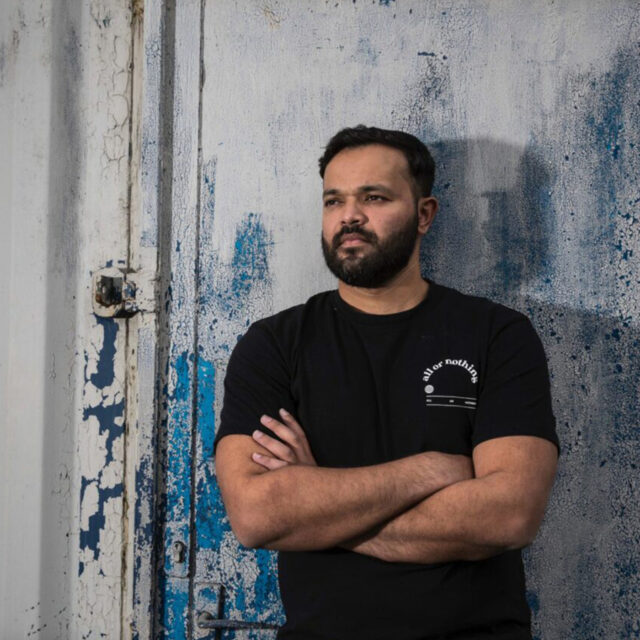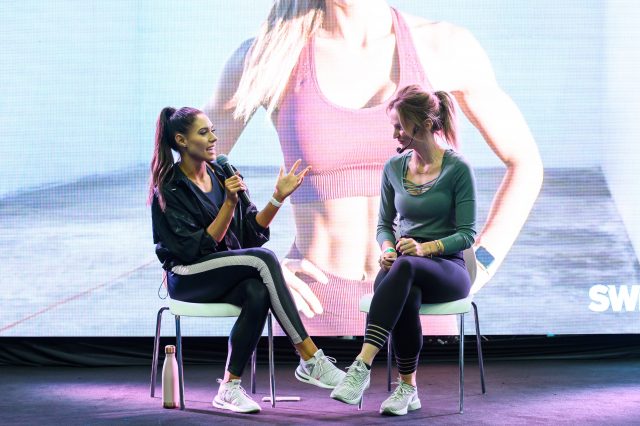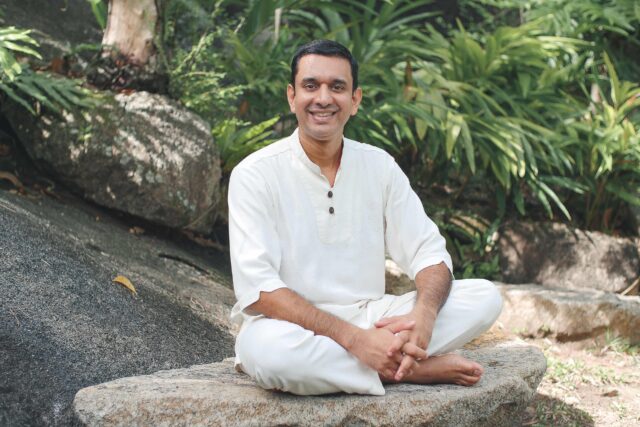With almost 150,000 followers on Instagram, a Men’s Health Middle East cover under his belt, and five years and counting as a coach with Adidas Runners in Dubai, Peter Barron is one of Dubai’s most recognizable personal trainers.
During the pandemic he launched his own online workout platform and program, Starcore, and now that concept has a physical space at The Alley DXB. Three times a week he and girlfriend Tana Boshoff offer 45-minute classes focusing on core strength, upper and lower body work and an element of HIIT. Peter joined The Livehealthy Podcast to talk about being called from Ireland to Dubai, recovering from Covid (twice), the importance of daily green ticks, and much more.
Tell us about Starcore…
The online side of things was doing well, but then in Dubai it seemed like there was a demand for an actual physical location. A friend of mine who’s a local here had a concept called The Alley. I don’t know if you know, but there was a big craze happening and is still happening, with padel tennis. Now, the actual venue has something very unique in the sense that it is glow-in-the-dark. When we were speaking, we were like, “wouldn’t it be perfect to collaborate and then create a fitness concept and then add in that element of darkness with the glow so it’s like you can work out?” What people have said just as feedback already is, it’s nice to get into your own zone. You’re not worried about the person beside you looking at what you’re doing, and you can just focus on the exercise and get in your own space.
What are the classes like?
I like to train with an element of strength, but I like everything to focus on my core. That’s for the simple reason of injury prevention. As you get older, if you have a strong core, it prevents you from certain diseases, anything that could happen that could debilitate you basically. You can’t walk or you have bad hips, and stuff like that.
People are still ignoring their core?
I wouldn’t say that people are ignoring it because, obviously, when you do strength training, by default, you’re working your core. If you have heavy weight on your back doing a squat, your core is what’s stabilizing you and is actually working. Whereas a lot of people don’t know that because you feel it on your legs mainly. I think now what’s happened is because of the way the fitness industry is, there’s a lot of noise, let’s say, online in terms of training styles.
If you want to lose weight and get fit, you have to do this super high-intensity bodyweight workout that for me, it works. Some people enjoy it, but it’s not the best, most efficient way to build a strong core. We want to get rid of the noise, have that focus on strength training because that is the fundamental. That’s what’s going to build that core strength and then still have that element of high intensity and ab or core-specific training aside that.
I’m glad you brought up the noise because I know just even covering this space, it’s really hard to just cut through it. What bothers you about what you’re seeing?
The number one problem I think in the fitness industry is what’s considered fit. Nowadays, fit is six-pack, washboard abs, these perfect shoulders, a big booty, and this is so far from the truth. A good example is, I don’t know if you follow boxing, but the world heavyweight champion at the moment in boxing, Tyson Fury.
You would say that he’s not necessarily fit because he doesn’t have a six-pack. The shape you would presume would be for a high-performing athlete, but he’s the pinnacle kind of fitness. You know what I mean? Fitness isn’t an image. I think now people use an image to create the concept of fitness and people will buy into that.
If I have the six-pack abs or the big bum that everyone thinks they want, then I can sell anything on the back of that. I can say you can take a certain pill or you can do a certain exercise and that’s going to get you those results, but that’s not necessarily true. Because the knowledge out there might not necessarily be as strong as it should be, people just buy straight into these programs.
Are you saying that you can do all the right things and be fit and not have that look?
I think to get to that level is a lot more difficult than what’s perceived in the fitness industry. I think for a lot of people, like let’s say someone now that’s a beginner. They see someone, a trainer that has a six-pack or whatever. They’re like, ‘I want that’.”The trainer says, ‘let’s work for six months and you’ll get it’. Now for someone that’s never trained before, it’s going to take six months or three to four months to build the fundamentals in terms of your form, your technique, your eating habits. It’s so much more than what you do in the gym. You need to build a new lifestyle.
Someone that’s not necessarily conditioned for the gym or that’s out of shape or overweight, it’s not because they didn’t go to the gym all their life, it’s because their daily habits are not right. It’s like, you need to start with your day-to-day habits, your nutrition, get all these things right, and then the rest will happen. For people to get to that level of fitness, should we say, it’s a lifetime commitment. You can’t just do it in three to four months and maintain it. It’s a commitment that you have to change your lifestyle indefinitely.
How honest are clients with you about what they do when they’re not with you?
This is the trickiest thing and it’s funny. It’s what I always tell people. It’s like, if I’m coaching somebody, I tell them that if you are going to pay me to be with you four days a week for four hours, this is the least and most important time you will have in the week. Yes, we will work on building strength and all that but if you don’t do the right thing on the other 23 hours of those days and 24 hours, the other days, what we will do will almost be a waste of time.

What’s your advice for people who are overweight and unhealthy? Where do they start?
The worst thing and what most people do is they try to jump into everything. They try to get the food, the training, all in one, and then they end up overwhelmed and if the weight then is going down, they feel good. The minute the weight goes up by two pounds, that’s it, I fail and they fall off track.
Don’t try a six-day a week in the gym. To start with, if you’re extremely overweight, two to three days a week, 20 to 30 minutes out for a walk, depending on your lifestyle. If you’re someone that’s very inactive, that’s going to bring you results straight away. Then all you have to do is increase that activity and intensity weekly and over time you’re going to win. Again, there’s no race, it’s a marathon, not a sprint.
What about walking?
Honestly, I’ve seen so many times where people, especially in Dubai, they’re trading really hard four times a week, and then you speak to them and they’re not getting the results they want and I’m like, ‘What do you do outside of those training days or sessions?’ They work nine-to-five jobs where they’re in front of a desk or computer. They go for their one-hour workout and they go back to the couch and do nothing.
Because in Dubai, I think Abu Dhabi is the same, if you are not conscious of the amount of steps you’re doing in a day, you can be sure you might be hitting a maximum of 3,000, 4,000 steps. Now, that’s considered, even with four workouts a week, very low activity. At the end of the day, it’s all an equation, it’s science. If you burn more calories in a day, if you’re in a deficit and you want to lose weight, you have to burn more calories daily than what you put in.
On top of the workouts?
People forget the workout isn’t to burn calories. Your workout is specifically to build strength so that when you build strength and to tone the muscle that’s already there so that when you do lose the weight, you have that shape and definition that you want. If you go to the gym with the intention of this is where I’m going to burn calories, and this is where I’m going to lose weight, with that mentality, I think you are on a losing path very quick.
And that you can actually still be a sedentary person if you’re working out three or four times a week…
You can. I think, first of all, for your mental health and for that alone, getting out to go for a 30-minute walk in today where you listen to a podcast or take time for yourself where you’re not on your phone and you’re not distracted by a computer, even if it’s in the middle of your working day, just get out, stretch out your body, let your mind relax a bit, treat it almost like a meditation. This will go leaps and bounds without even thinking about the fitness aspect of it.
How was your Covid experience?
I used the Whoop, I don’t know if you’ve heard of it but it’s basically like a fitness tracker that monitors your heart rate, your heart rate variability, your respiratory rate. When I caught it, my respiratory rate really dropped. When that drops it means something is going in your body that’s not good. Then I got extremely sick. In my mind, I was at the highest fitness level that I could’ve been at, and I got really, really sick.
The second time I got it, it was a lot milder. Obviously, I had really focused in on nutrition, supplementation. I think for me I needed B12, vitamin D, things like this that I wasn’t supplementing with on their own. I think this played a big part in reducing it.
Did you have any long-term holdover from COVID? Did you do anything if you did?
I did. Again, we’re not going too technical on it but I track everything on my Whoop. My heart rate variability, which is the milliseconds between each heartbeat, used to be very high, used to be up in the hundreds. For six or seven months after COVID, it was really, really low, below 100 and I was struggling to breathe, even just a fast walk, and I would find that I was struggling to catch my breath.
I decided to really work on my cardiovascular fitness, which is something that I would’ve done just as my default with my training before but this time I have to really work on it. I managed to get it back up to a good level. Then I caught COVID again, and it dropped, and since, I’ve been working on trying to lift it again. I do think it definitely plays a big part with our lungs and our respiratory system which makes it hard, obviously.
If you are into running or any sort of sport, it definitely has negative side effects. I think trying to keep on top of that cardiovascular health is super important.
What’s your advice for people to get strong when they recover??
For me, if I tried to go back in at the same level before I got COVID, what would have happened is I probably would’ve blown my hamstring or some muscle probably would’ve suffered because my body wasn’t able to take the same level of strain. I would’ve thought, ‘okay, it’s only two or three weeks since I had it. Now I feel fine again, let’s push it hard’.
If you do that and your body is not ready, you could end up with some serious injuries that you end up having to deal with and end up with six months out of training. I think you definitely have to ease yourself back in. Again, it’s not a sprint, it’s a marathon in the long term so there’s no rush with it.






